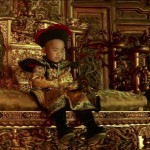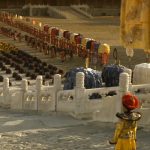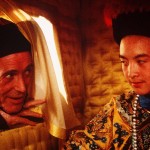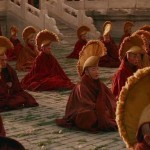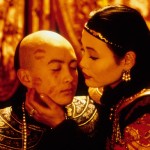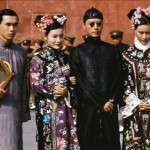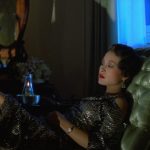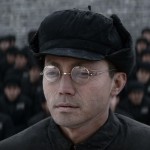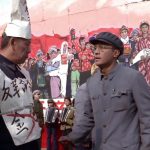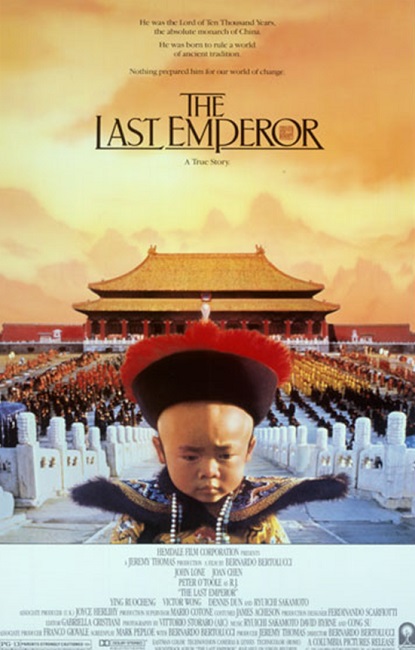
The Last Emperor – 1987
The Last Emperor was a large movie. It was nearly 3 hours long, a bit slow for my tastes, but visually stunning. There is no doubt that it was a good movie. The production values were of the highest standard. There was clearly a great attention to detail in the costumes, filming locations, props and the like. The casting was very good, though the only name I recognized was Peter O’Tool.
However, he was only a minor character. The main plot of the film was carried by actor John Lone who played the part of the adult Puyi, the last Emperor of China. He reigned from 1908 at the age of 3 until he was forced to abdicate the throne in 1912 at the age of 7. He remained in the palace of the Forbidden City for the next 12 years until he was expelled in 1924. The film continues to follow Puyi over the course of his life as he is re-crowned as a puppet emperor for Japanese invaders in 1932, captured by the Russian army in the Pacific War in 1949, and imprisoned for ten years in the Fushun War Criminals Management Center until his release from government rehabilitation in 1958. At that point he was 53 years old. Then a few brief scenes are shown of him just before his death in 1967 at the age of 62. At that point, he was a simple gardener living the life of a peasant.
Of course those are just the bare highlights of his life. There are, of course many more details that the movie covered and we’ll get to those in a bit, but something has to be mentioned first: The magnificent Forbidden City. Apparently The Last Emperor was the first Western motion picture that the Chinese government allowed to film in the historical building. The Forbidden City is a phenomenal palace that was built in the early 1400s for use as a residence for the Emperors of China and their families. It was used as such for 500 years. Located in the center of Beijing, it is an easily recognizable structure that is now a tourist attraction and museum.
Interesting note: The Forbidden City is actually named Zijin Cheng which is translated as Purple Forbidden City. Purple refers to Ziwei, the North Star, which in Chinese Mythology is the abode of the Celestial Emperor. The Forbidden City was the home of his counterpart, the Terrestrial Emperor.
Director Bernardo Bertolucci spent the first 90 minutes of the film taking full advantage of beauty of the Forbidden City. The coronation scene was one of particular magnificence. The film used over 19,000 extras, many of whom were in that scene. Each one of them had to be clothed in period specific Chinese ceremonial garb, circa 1908, which must have been a pretty daunting task for costume designer, James Acheson. He really deserved the Oscar he won for his work. The costumes for the Emperor were gorgeous and regal. Well done, James.
Interesting note: Many of the extras in the film were drafted from the Chinese Army.
The Forbidden City is grand and ornate. The architecture is exquisite and easily recognizable. The throne itself is a work of art done in gold. When Puyi took the throne he was too young to appreciate its splendor and kept begging to be allowed to go home, though this request was denied him. His only friend was his wet nurse. I found it a bit creepy, but strangely believable that he was still breast-feeding at age 10 or so. The serving staff waited on him hand and foot, so much so that he had no idea how to take care of himself. He couldn’t even tie his own shoes.
While Puyi still lived at the Forbidden City, a wife was chosen for him, and he was allowed to choose his own consort, or secondary wife. His first wife, the Empress Wanrong was played by Joan Chen. She was beautiful and played her part well. Later on in the film, she becomes an opium addict and suffers a tragic fate. I thought she did a good job.
John Lone, though, did a fantastic job. As with most epics of this nature, he had to play the same character in different phases of his life – in this case, from around 21 to 62. The makeup can only do so much. As good as the makeup is, the actor has to act the part properly. I have seen it done right and I have seen it done wrong. Lone did just fine. Of course, several other ages were needed for the film. Richard Vuu was the 3 year-old Puyi. Tijer Tsou played him at 8 years old. And finally, Wu Tao was Puyi at 15 years-old. It is the job of the casting director to find actors that look similar enough as to be believable as the same person. There isn’t an Academy award for Best Casting, but whoever this person was, maybe he would have won.
Peter O’Tool played the part of Reginald Johnston, Puyi’s Scottish tutor. O’Tool is generally a fine actor, and he performed the role passably well. My problem with his portrayal was that they made the point of saying that he was a Scotsman. But he had a distinctly British accent. Only once did I hear anything come out of his mouth that resembled a Scottish accent. However, it was only for one brief sentence and it never came back. If you can get past that little detail, he did OK.
I have to give a special thumbs-up to the producer Jeremy Thomas. The reason for this is that he independently funded the entire film. On his own, he raised the $25 million needed to make the film without any studio backing him. Once the film was made, he struck a deal with Columbia Pictures to distribute the movie in North America, but other than that, he did it all single-handedly.
Interesting note: According to my research, (back to Wikipedia again…) I found that at some point, in order to raise money, Thomas was scouring the phone book in search of potential financers.
The soundtrack was very well done. As you might expect, the music had a distinctly Chinese flare that did a great job of putting you right in the middle of the mysterious far-east. The music made use of authentic Chinese instruments that traditionally have that high squeaky quality that should be annoying, and often is to my American ears. But within the context of the film, it was appropriate. I would have expected nothing else. In fact, it was even very beautiful at times and had a certain ancient and timeless feel.
And that brings me to something that I was not sure I was going to mention in my review. The opening credits. Usually, opening credits are not particularly noteworthy, but they caught my attention in this movie. All they did was show bright and colorful images of intricate and yet mostly indistinct backgrounds that were nonetheless very beautiful as the names of the actors were flowing on and off the screen. It was very pretty and, I thought, somewhat reflective of the ornately beautiful traditional clothing of China. And of course, the beautiful Chinese-sounding music that played over the credits caught my attention.
When I reflect on the life of Puyi as it was depicted in The Last Emperor, I have to agree with Johnston’s assessment in the film. Puyi had to be the loneliest boy alive. With all the servants and staff at his command, not one of them was allowed to be a friend to him. They were all too busy falling all over themselves to serve him. With all the power he had, the ability to have anything he desired, he had remarkably few opportunities to be in control his own life. He was at the mercy of his position as Emperor.
And it was just sad that he ended up with nothing, no family, no servants, no money, no position, and no title. But I also think that a small part of him must have been happier like that, happier with the freedom that the life of a peasant must have allowed him. As Emperor, he was a prisoner. As a peasant he was free.
Finally, I have to mention the Chinese Republic prison in which he spent ten long years. In fact, the film opened with him being taken to the prison in 1950. So really, the story of his life, the lion’s share of the movie, was all told in flashback. Every now and then, to neatly divide up his life into its different eras, the story would return to the prison. Here he ran into several people that he knew when he was the Emperor of all China. Out of habit, he still treated them like servants until they began to complain both to him and to the prison guards. It really brought home the fact that he was no longer Emperor.
One of the guards actually befriends him and helps/forces him to learn to take care of himself. While in incarceration, he sees a propaganda film displaying Japanese war atrocities and actually repents, admitting his forced participation as a puppet Emperor for the Japanese. He is released from prison in 1958.
The film ends in a very clever way. As a simple tourist, at the age of 63 or so, Puyi visits the Forbidden City, his former home. It is now a museum. It is nearly deserted as he climbs over the guard rope to ascend to the throne upon which he once sat. Before he can sit on the throne he is stopped by a young child wearing the red scarf of the Communist Pioneer Movement. He tells the child that he was once the Emperor of all China. The boy demands proof. In answer, Puyi reaches behind the throne to a secret place where he had once hidden a small jar containing a cricket that had been given to him as a gift when he was a child. Somehow, the 60 year old cricket was still alive inside the jar, but never-mind that. The child releases the insect and believes Puyi, but when he looks back in wonder, Puyi is gone. Enigmatic and mysterious, to be sure. Much like ancient China, itself.
This was ultimately a good movie. It was a bit too long and slow for my tastes, but definitely worth watching, a worthy Best Picture winner.
